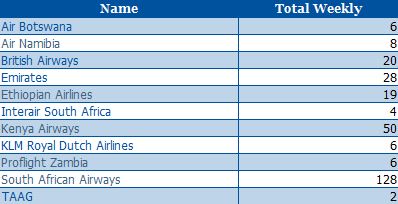Zambia's booming economy increasingly reliant on Kenya and Ethiopian Airways. A flag carrier needed?
As southern Africa enjoys a commodities boom, Zambia, like its neighbour Zimbabwe lacks an international airline of its own, leaving the country reliant on a small number of foreign airlines to provide connections to tourism markets and trading partners. British Airways' decision to pull out of Zambia in Oct-2013 after 80 years of service is a considerable blow to European connections. BA will redeploy the capacity to Ghana where greater returns are in view following Virgin Atlantic's withdrawal.
Privately owned Proflight Zambia operates a domestic network in Zambia and the seemingly prudently run airline has regional expansion plans, but is unlikely to be able to extend its business beyond Africa in the foreseeable future.
Zambia's Government has been attempting to negotiate a funding deal to relaunch a flag carrier to replace Zambia Airways, liquidated in 1995 after 31 years' operation. However, the unhappy history of African governments meddling in the affairs of their national carriers means private investors are reluctant to become involved. Meanwhile, Africa's hub carriers like Kenya Airways and Ethiopian Airways are increasing service.
Zambia relies on six large foreign airlines to provide its international links
Land-locked Zambia relies heavily on foreign carriers to provide international links, particularly South African Airways (SAA), Kenya Airways, Emirates, British Airways, Ethiopian and KLM.
South African is the biggest provider of international capacity to Zambia accounting for more than 26% of total capacity followed by Emirates with 18% and Kenya Airways with 16.3%.
Zambia International Schedule Summary: as at 10-Oct-2013
But the lack of foreign capacity to Zambia is illustrated by British Airways ranking in the top six foreign carriers although it has only three flights per week from London to Lusaka.
British Airways will suspend services to Lusaka in Oct-2013 as Ghana becomes more attractive
British Airways, however, will suspend its three times weekly service from 27-Oct-2013 after some 80 years of service. British Airways' departure will leave KLM as the only direct link to Europe. KLM operates four frequencies per week between Amsterdam and Lusaka with an A330. The carrier launched on the route in May-2012 which it triangulates via Harare.
KLM's late evening departure from Lusaka allows for a mid-morning arrival in Amsterdam and convenient connections to the United States. British Airways' 767 service departs Lusaka in the morning, arriving at London Heathrow 18:05, limiting onward connections.
British Airways has not specified a reason for withdrawing from Lusaka, but the carrier has been expanding its presence in other parts of Africa, in particular West Africa where it will add another 616 seats by the end of Oct-2013.
The service will partly replace the 1,230 one-way seats per week capacity reduction from Virgin Atlantic, which suspended its London Heathrow-Accra service in Sep-2013.
British Airways currently operates daily with 777s between London and Accra and will redeploy the 767 capacity used on the Lusaka service to Accra to boost frequencies on the route to 10-times weekly.
Emirates covers Lusaka and Harare with double dailies, providing mostly Asian and Eastern Europe connections
Emirates offers double daily frequencies between Dubai and Lusaka using A340-300s, continuing on to Harare. Emirates commenced the service in Feb-2012 offering 1,240 one-way seats per week and more than doubled capacity to about 2,580 seats in a year until Sep-2013 when capacity was reduced to the current 1,869 seats. For both Emirates and KLM the Harare tag improves passenger load optimisation.
The routing to Europe and the United States is more circuitous via Dubai, making the Emirates' service more valuable for Eastern and Asian destinations in competition with Kenya Airways and Ethiopian's hubs at Nairobi and Addis Ababa respectively.
No Asian carrier currently serve Zambia, but Zambia's President Michael Sata in Oct-2012 requested Korean Air to launch a service to promote tourism and trade links.
Kenya Airways has more than doubled capacity between Nairobi and Lusaka in 2013
The lack of northbound competition has made Lusaka more attractive for Kenya Airways though. The SkyTeam member and KLM partner will increase capacity on the Nairobi-Lusaka route to a peak of 2,018 one-way seats per week in Nov-2013 - almost double the volume offered in Mar-2013.
The carrier currently operates 50 frequencies per week from Nairobi to Zambia, including eight to Lusaka and three each to Ndola and Livingstone. Kenya Airways launched its Nairobi-Livingstone-Harare-Nairobi service in Jun-2013 using Embraer E190s, with Livingstone as the carrier's third destination in Zambia after Ndola, which goes on to Lubumbashi, was launched in Apr-2013.
The Lusaka services now continues on to Lilongwe after Malawi granted Kenya Airways fifth freedom rights to operate the route in Jun-2013, which reportedly also include rights to serve Blantyre, though these have not yet been taken up.
Kenya to Zambia (seats per week, one way): 19-Sep-2011 to 30-Mar-2014
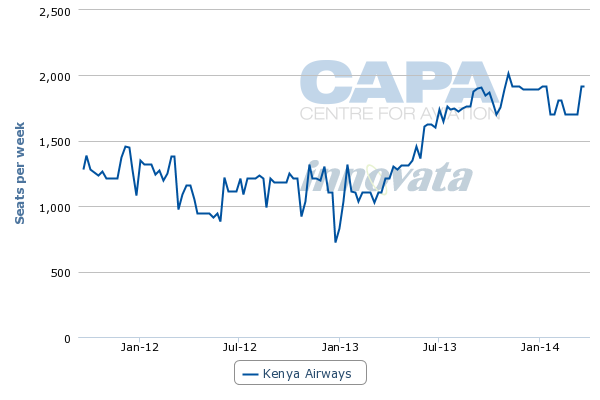
Ethiopian Airways also offers connecting hub opportunities northbound. The airline currently operates eight frequencies to Zambia from Addis Ababa, including five to Ndola and three to Lusaka. Ndola was added in Jul-2013 as the carrier's second destination in Zambia after services to Lusaka were recommenced in Feb-2013 following an 11 month suspension.
Ndola, the third largest city in Zambia, is the industrial and commercial centre in the copper belt province of the country.
South African Airways is Zambia's biggest provider of international air services
SAA dominates the South Africa to Zambia market, operating from Johannesburg to Lusaka 29 times weekly, Livingstone daily and Ndola 15 times weekly. It also flies from Durban to Lusaka four times per week and from Kruger to Livingstone five times weekly.
SAA increased capacity to Zambia from about 4,000 one-way seats per week in Sep-2011 to about 5,500 seats in Sep-2012. Of this increase approximately 550 seats were added to the Johannesburg-Lusaka route taking the total to about 3,200 seats per week and about 640 one-way seats per week between Johannesburg and Ndola for a total of 1,126 seats.
SAA has the Johannesburg-Lusaka route to itself but competes with Interair South Africa on Johannesburg-Ndola which operates twice daily weekly with a 737-200.
See related report: South African Airways continues push into Central Africa
Zambia total capacity (seats) per week by carrier: 7-Oct-2013 to 13-Oct-2013
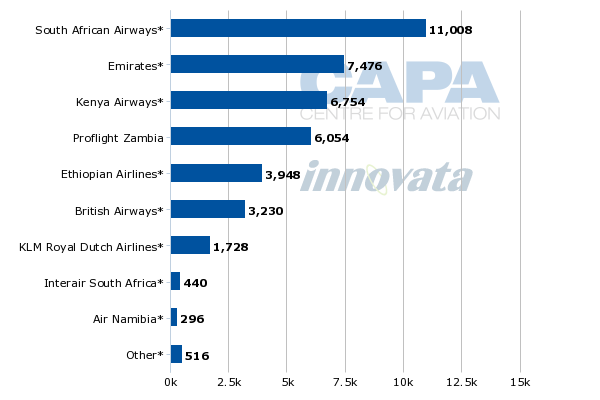
Comair's British Airways franchise operation competes with SAA between Johannesburg and Livingstone, offering about 1,000 one-way seats per week compared to SAA's 840 seats. Both carriers provide a daily service.
Zambia to South Africa (seats per week, one way): 19-Sep-2011 to 30-Mar-2014

South Africa accounts for nearly 38% of Zambia's international capacity, followed by Zimbabwe with about 21% and Kenya and United Arab Emirates with a little over 10% each.
Zambia international capacity (seats) by country: 7-Oct-2013 to 13-Oct-2013
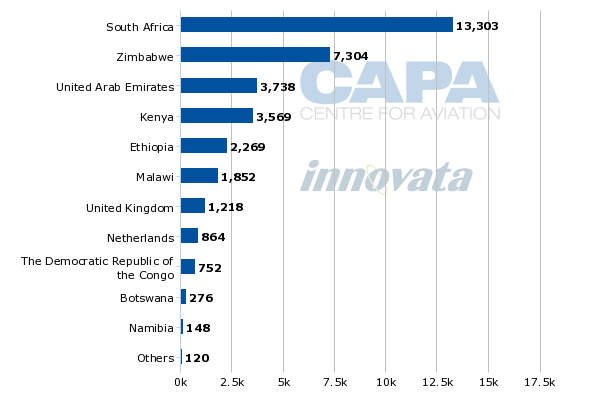
Proflight Zambia plans to launch regional services, replacing Zambezi Airlines
Proflight Zambia traces its origins back to 1991 when it was founded as regional charter carrier, Proflight Air Services. The privately owned carrier commenced scheduled services to the copper belt, Luangwa Valley, Victoria Falls and Lower Zambezi in 2004.
The carrier was rebranded as Proflight Zambia in 2010 and operates a scheduled domestic network of eight destinations and a single regional route to from Lusaka to Lilongwe which was launched in Jun-2013 effectively replacing an Air Malawi service which ceased in Feb-2013. Proflight Zambia's 87 one-way seats per week offering on the route, however, competes with Kenya Airways' 708 seats increasing to 932 seats in Nov-2013.
Proflight Zambia route map
Proflight Zambia became Zambia's sole domestic carrier after the collapse of regional alliance partner Zambezi Airlines which suspended operations in Oct-2012 due to liquidity issues. Zambezi was previously temporarily grounded in Nov-2011 by the Zambia Civil Aviation Authority over safety concerns. The carrier had been seeking new equity partners but has so far failed to relaunch.
Zambezi operated a regional network including services to South Africa, Tanzania and the Democratic Republic of the Congo.
Proflight Zambia has announced plans to commence three times weekly Lusaka-Dar es Salaam services from 23-Oct-2013 as its second regional destination, using a 29-seat Jetstream 41. The carrier is also considering services to Harare, Johannesburg and Tete, Mozambique in mid-2014.
Proflight Zambia director of government and industry affairs Philip Lemba reportedly stated in Aug-2013: "We believe that after years of prudent, steady growth, Proflight Zambia has now built a solid base and reached a critical mass from which it can expand into regional markets."
Proflight Zambia operates a scheduled air services fleet of eight aircraft according to its website, including a 737-200, two Jetstream 41s, three Jetstream 32s and two C208s. In addition the carrier operates a fleet of three C401/402s two Britten Norman Islanders and two Beech Barons for charter services.
The carrier's determination to be the "standard bearer" for Zambian regional aviation could however come under pressure with the Zambian Government's decision to launch a new flag carrier.
The Zambian Government plans to launch a new national airline to replace long defunct Zambia Airways - but words haven't translated to reality
Zambia's Government stated in May-2013 that it was on track to establish a new national airline by the end of 2013. The government was at that time in discussions with three unidentified airlines for an equity stake of up to 40% in the proposed carrier. At the time the government said that preparations for the new carrier were about 60% complete.
The government had reportedly been in discussions since 2011 with would-be start-up Fly Zambia about establishing a national carrier under a public-private partnership (PPP).
The carrier would have been managed by South African and Zambian investors and would operate a small regional network to Angola, The Democratic Republic of the Congo, South Africa and Zimbabwe.
Zambia is investing in upgrading its main airports at Lusaka, Livingstone, Ndola and Mfuwe
In a bid to attract more capacity and improve connectivity, Zambia plans to redevelop the country's main airports at Lusaka, Livingstone and Ndola. The work involves the construction of a new airport at Ndola, a new terminal at Lusaka, a second runway at Livingstone and a new international terminal at Mfuwe.
The new USD200 million terminal at Lusaka was opened in Aug-2013 in time for the UN World Tourism Organisation (UNWTO) General Assembly. The terminal reportedly has a capacity for 700,000 passenger per year and is part of a planned larger USD500 million upgrade of the airport, which includes new aprons, taxiways and a control tower.
Lusaka is the nation's main gateway and has the only runway able to accommodate long-haul services.
Zambia top 10 airport (seats): 7-Oct-2013 to 13-Oct-2013
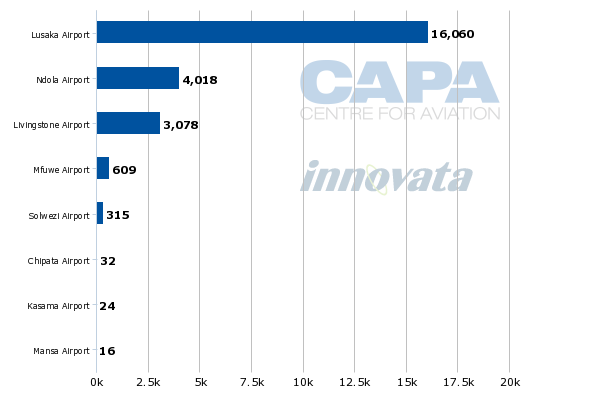
The government in May-2013 approved a 2000ha site northwest of Ndola for the construction of a new international airport to replace Ndola Airport. The new USD520 million airport will reportedly have capacity for two million passengers per annum with scope for future expansion. The current airport is reportedly being replaced to make way for the region's mining industry.
No time frame has been given for redevelopment work or the construction of a planned second runway at Livingstone or the new international terminal at Mfuwe.
Zambia's airport investment is promising, but a national airline free from political interference is a priority
Zambia's planned investment in its aviation infrastructure is a welcome development for a land-locked nation with few other shipping options available to take advantage of its rapidly growing economy, largely driven by its copper mining industry.
But the country needs to thicken its international route networks if the mining industry is to flourish. So long as there is no Zambian flag carrier, it must rely on foreign airlines provide the connectivity, both regional and intercontinental.
In theory the best way to do that is by encouraging private investment in local airlines and a national carrier that has the growth of its home market as a priority.
But for that to happen will require a massive change in mindset from the government's protective and meddlesome ways; recent mixed signals about aircraft orders has done little to inspire confidence that a public-private partnership in a national airline would be any more successful than in the past.
Meanwhile too, restrictive bilateral agreements across most of Africa make access for other airlines more cumbersome than necessary. In Zambia's case this is clearly having a dampening impact on economic development.
